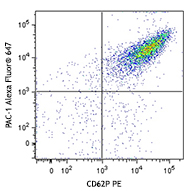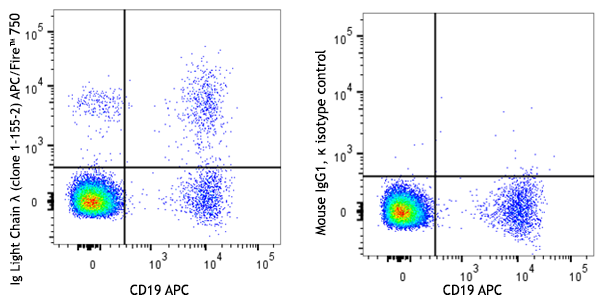- Regulatory Status
- RUO
- Other Names
- TNF-α, IL-10, IFN-γ, CXCL1 (KC), CCL2 (MCP-1), GM-CSF, IL-18, IL-12p70, IL-1β, IL-17A, IL-33, IL-1α, IL-6
- Ave. Rating
- Submit a Review
- Product Citations
- publications
Inflammation is a major part of the immune response to infection or tissue injury. It is mediated by various cytokines and chemokines. Inappropriate activation of inflammatory responses is the underlying cause of many common diseases and inflammatory reactions. Therefore, accurate measurement of inflammatory cytokines is important for understanding the immune responses and disease processes.
The LEGENDplex™ Rat Inflammation Panel V02 is a bead-based multiplex assay panel, suitable for use on various flow cytometers. This panel allows simultaneous quantification of 13 rat cytokines, including IL-1α, IL-1β, IL-6, IL-10, IL-12p70, IL-17A, IL-18, IL-33, CXCL1/KC, CCL2/MCP-1, GM-CSF, IFN-γ and TNF-α. Most of cytokines in this panel are produced by innate immune cells, linking the innate and adaptive immunity with other cells. This assay panel provides higher detection sensitivity and broader dynamic range than the traditional ELISA method. The panel has been validated for use on cell culture supernatant, serum and plasma samples.
Kit Details
- Kit Contents
-
- Setup Beads: PE Beads (1 mL)
- Setup Beads: Raw Beads (1.8 mL)
- LEGENDplex™ Rat Inflammation Panel V02 Premixed Beads (3.3 mL)
- LEGENDplex™ Rat Inflammation Panel Detection Antibodies V02 (3.3 mL)
- LEGENDplex™ Rat Inflammation V02 Standard A (1 vial)
- LEGENDplex™ Rat Inflammation V02 Standard B (1 vial)
- LEGENDplex™ Matrix C, Lyophilized
- LEGENDplex™ SA-PE (3.3 mL)
- LEGENDplex™ Assay Buffer (25 mL)
- LEGENDplex™ Wash Buffer, 20X (25 mL)
- Plate Sealers (4 sheets)
- LEGENDplex™ Lyophilized Standard Reconstitution Buffer (5 mL)
- V-bottom Plate
- Materials Not Included
-
- Flow Cytometer
- Pipettes and Tips
- Reagent Reservoirs for Multichannel Pipettes
- Polypropylene Microfuge Tubes
- Vortex Mixer
- Sonicator
- Aluminum Foil
- Absorbent Pads or Paper Towels
- Plate Shaker
- Tabletop Centrifuges
- Centrifuge with a swinging bucket adaptor for microtiter plates (if using V-bottom plates)
- 1.1 mL polypropylene micro FACS tubes, in 96-tube rack
Product Details
- Verified Reactivity
- Rat
- Application
-
Multiplex - Panel
Learn more about LEGENDplex™ at biolegend.com/legendplex
Download the LEGENDplex™ software here.
Antigen Details
- Biology Area
- Cell Biology, Innate Immunity, Neuroinflammation, Neuroscience
- Molecular Family
- Cytokines/Chemokines
- Gene ID
- 24835 View all products for this Gene ID 64546 View all products for this Gene ID 3586 View all products for this Gene ID 24494 View all products for this Gene ID 25712 View all products for this Gene ID 301289 View all products for this Gene ID 81503 View all products for this Gene ID 361749 View all products for this Gene ID 24770 View all products for this Gene ID 24494 View all products for this Gene ID 116630 View all products for this Gene ID 24498 View all products for this Gene ID 29197 View all products for this Gene ID
Related Pages & Pathways
Pages
Related FAQs
- If I don't have a vacuum, how do I remove the liquid from my plate?
-
If you do not have a vacuum, the assay should be run in a V-bottom plate. After centrifugation using a swinging-bucket rotor with a plate adaptor, you can remove the liquid by flicking the plate quickly, dumping the contents into a sink, and patting it dry carefully on a stack of clean paper towels without losing the beads. Alternatively, you can remove the liquid by using a pipette.
- Should I perform the assay with the filter plates or with V-bottom plates?
-
Filter plates or V-bottom plates have been included in some kits for your convenience. A vacuum filtration unit is required to work with the filter plates. However, if you don’t have access to a vacuum manifold or if you prefer, then you can use the V-bottom plates and follow the recommended assay protocols for the type of plates you choose. All plates should be made from low binding polypropylene. Polystyrene ELISA or cell culture plates should not be used.
- After I finish the staining process, how long can I wait before reading my LEGENDplex™ samples?
-
The samples can be kept overnight at 4°C while being protected from exposure to light and be read the next day. There may be a decrease in signal, but overall, the assay results should not be affected. Storing the samples for extended periods of time is not recommended, as it could lead to further reductions in signal.
- What is the shelf life of LEGENDplex™ kits?
-
LEGENDplex™ kits are guaranteed for 6 months from the date of receipt, but may have a shelf life of up to 2 years from the date of manufacture.
- Is special software required for data analysis?
-
Typically flow cytometers generate output files in FCS format (e.g. FCS 2.0, 3.0, or 3.1) and in some cases in list mode file format (LMD). Other software may be available to analyze FCS files. Data generated using LEGENDplex™ kits can be analyzed using the freely available LEGENDplex™ data analysis software. Please check our website for the most updated versions of the software.
 Login / Register
Login / Register 












Follow Us